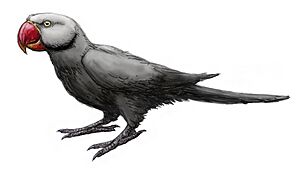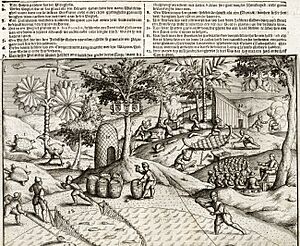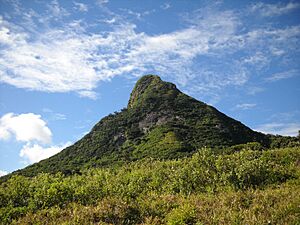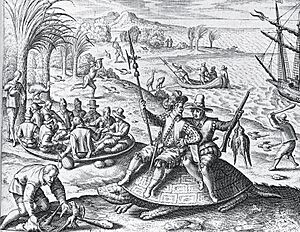Mascarene grey parakeet facts for kids
Quick facts for kids Mascarene grey parakeet |
|
|---|---|
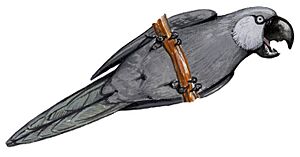 |
|
| Life restoration by Julian P. Hume | |
| Conservation status | |
| Scientific classification | |
| Genus: |
Psittacula
|
| Species: |
bensoni
|
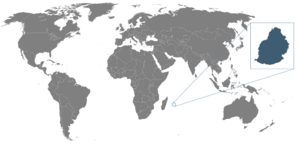 |
|
| Location of Mauritius, where subfossils of this species have been found | |
| Synonyms | |
|
Lophopsittacus bensoni Holyoak, 1973 |
|
The Mascarene grey parakeet was an extinct parrot. It was also called the Mauritius grey parrot or Thirioux's grey parrot. This bird lived only on the Mascarene Islands of Mauritius and Réunion. These islands are in the western Indian Ocean.
Scientists first found bones of this parrot on Mauritius in 1973. They thought these bones belonged to a relative of the broad-billed parrot. Later, these bones were linked to old descriptions of grey parrots from the 1600s and 1700s. A drawing from 1602 also helped identify the bird. Because of these findings, the parrot was placed in the Psittacula group.
The Mascarene grey parakeet was grey and had a long tail. It was larger than most other Psittacula parrots, which are usually green. These parrots were easy to hunt. If one was caught, it would cry out, and its whole flock would come. People also saw them as pests that ate crops. Hunting them a lot, along with deforestation, led to their disappearance. They vanished from Réunion by the 1730s and from Mauritius by the 1760s.
Contents
Discovering the Mascarene Grey Parrot
In 1973, a scientist named Daniel T. Holyoak found some small parrot bones. He found them among bones of the broad-billed parrot at the Zoology Museum of Cambridge University. These bones had been collected earlier by Louis Etienne Thirioux. He found them in a cave on Le Pouce mountain in Mauritius.
Holyoak noticed the bones were similar to other Mascarene parrots. But they were smaller and stronger. He first named the new species Lophopsittacus bensoni. The name "bensoni" honored another bird expert, Constantine W. Benson. Later, more bones were found in the Mare aux Songes swamp on Mauritius. This swamp has many fossils of extinct birds.
Connecting Bones to Old Stories
Old stories about different extinct parrots from the Mascarenes were confusing. In 1967, some thought the grey parrots mentioned in old reports were broad-billed parrots. But in 1987, Anthony S. Cheke linked the L. bensoni bones to the grey parrots seen on Mauritius and Réunion. Further study showed that the broad-billed parrot was not grey. It had many colors.
In 2007, Julian P. Hume reclassified the parrot. He moved it to the Psittacula group. He found its bones looked like those of the Alexandrine parakeet. Hume also thought an engraving from 1648 might show this parrot. The drawing shows people hunting dodos and parrots on Mauritius in 1602. The way they caught parrots in the drawing matches old stories about the Mascarene grey parakeet. Hume gave it the new name "Thirioux's grey parrot." But the IOC World Bird List uses "Mascarene grey parakeet."
Scientists believe the grey parrots on Réunion were the same species as those on Mauritius. But this can't be fully confirmed until their bones are found on Réunion.
How They Evolved
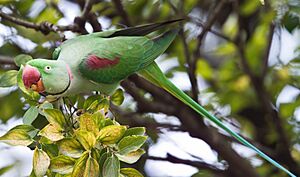
Scientists think the Alexandrine parakeet might be the ancestor of all Psittacula parrots on Indian Ocean islands. These parrots spread south from their home in South Asia. Many birds from the Mascarenes, like the dodo, also came from South Asian ancestors. This might be true for all parrots there too.
Most extinct parrots from the Mascarenes are not well known. But their bones show they had big heads and jaws. They also had strong leg bones. Scientists think they all came from the same group of parrots called Psittaculini. This group has spread to many isolated islands. Other Psittacula parrots from the Mascarenes include the echo parakeet and Newton's parakeet.
Recent genetic studies show that the Psittacula group might need to be split. This means some parrots currently in Psittacula might be moved to new groups. For example, the echo and Newton's parakeets might be moved to the genus Alexandrinus.
What They Looked Like
Old descriptions say the Mascarene grey parakeet was a grey parrot with a long tail. Its beak was about 29% longer than the echo parakeet's. It was also wider. Parrots in the Psittacula group often have large, red beaks and long tail feathers. The middle tail feathers are usually the longest.
The Mascarene grey parakeet was smaller than the broad-billed parrot. But it was similar in size to the Mascarene parrot. It had a wider beak than the Mascarene parrot. Its grey color also made it different from most other Psittacula parrots, which are usually green.
Their Daily Life and Habitat
Scientists believe the Mascarene grey parakeet spent a lot of time on the ground. It might have eaten fruits from hurricane palm and bottle palm trees. These trees were common where the parrots lived. The Mascarene grey parakeet lived on both Mauritius and Réunion.
People said these parrots were easy to hunt. If you caught one and made it cry out, a whole flock would come. This made it simple to catch many birds.
Willem van West-Zanen visited Mauritius in 1602. He was the first to write about the grey parrots there. He also described how they were hunted:
...some of the people went bird hunting. They could grab as many birds as they wished and could catch them by hand. It was an entertaining sight to see. The grey parrots are especially tame and if one is caught and made to cry out, soon hundreds of the birds fly around ones’ ears, which were then hit to the ground with little sticks.
Another sailor, Willem Ysbrandtszoon Bontekoe, saw the same behavior on Réunion in 1618. He wrote:
Coming further inland we found [a] great number of geese, doves, grey parrots and other birds, also many land-turtles... And what we most did marvel at, when we held one of the parrots and other birds and squeezed it till it screamed, there came all the others from thereabout as if they would free it and let themselves be caught as well, so we had enough of them to eat.
In 1705, Jean Feuilley described the parrots of Réunion. He said:
There are several sorts of parrot, of different sizes and colours. Some are the size of a hen, grey, the beak red [Mascarene parrot]; others the same colour the size of a pigeon [Mascarene grey parakeet], and yet others, smaller, are green [echo parakeet]. There are great quantities, especially in the Sainte-Suzanne area and on the mountainsides. They are very good to eat, especially when they are fat, which is from the month of June until the month of September, because at that time the trees produce a certain wild seed that these birds eat.
Many other animals on Mauritius and Réunion also disappeared after humans arrived. This caused a lot of damage to the ecosystems of these islands. Before humans, the islands were covered in forests. Very little of these forests remain today because of deforestation.
On Mauritius, the Mascarene grey parakeet lived with other extinct birds. These included the dodo, the red rail, and the broad-billed parrot. On Réunion, it lived with the Réunion ibis and the hoopoe starling.
Why They Disappeared
When sailors visited the Mascarene Islands from 1598, they mostly hunted animals for food. Only one of the eight parrot species from the Mascarenes, the echo parakeet, is still alive today. The others likely disappeared because of a lot of hunting and deforestation.
The Mascarene grey parakeet was easy to catch. So, early visitors to Mauritius and Réunion hunted them often. They were especially hunted from June to September when they were fat. One account from 1606 even says that grey parrots on Mauritius were sometimes killed just for fun.
In the 1720s, Sieur Dubois said the grey parrots on Réunion were popular during their fat season. He also said they were crop-pests:
Grey parrots, as good [to eat] as the pigeons... All the birds of this island have their season at different times, being six months in the low country and six months in the mountains when returning, they are very fat and good to eat... The sparrows [Foudia], grey parrots, pigeons and other birds, bats [Pteropus sp.], cause plenty of damage, some to cereals others to fruit.
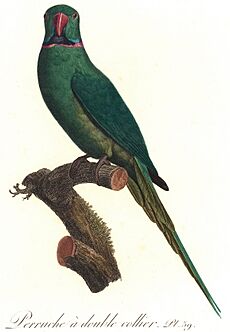
Since these birds were said to damage crops, it probably made people hunt them more. French settlers started clearing forests in the 1730s. They used a method called slash-and-burn. This would have greatly harmed the parrot population. Parrots and other animals often nest in tree holes.
The grey parrots seemed common on Mauritius until the 1750s. This was despite human activity. But they were last mentioned in 1759 (published in 1764). So, they likely became extinct soon after that. The grey parrots of Réunion were last mentioned in 1732.
An engraving from 1648, which might show this species, had a Dutch poem. Here is a translation:
For food the seamen hunt the flesh of feathered fowl,
They tap the palms, and round-rumped dodos they destroy,
The parrot's life they spare that he may peep and howl,
And thus his fellows to imprisonment decoy.



